Are You A Vanguard? Applications Now Open
High school students from Chicago's Washington Park neighborhood contribute to Sweet Water Foundation's aquaponics program.
Photo courtesy Sweet Water Foundation
This is your first of three free stories this month. Become a free or sustaining member to read unlimited articles, webinars and ebooks.
Become A MemberOn a Sunday afternoon in June, with the temperature well above 80 degrees, the Perry Avenue Commons on Chicago’s South Side bustles with a remarkable amount of activity. By the end of a warm weekend, you’d expect things to be winding down. But six or so volunteers and mentors tend vegetable plots of kale and leafy greens at one end of a four-block-by-four-property, part of a commercial farm and community garden managed by the nonprofit Sweet Water Foundation. A group who met at the commons for the women’s retreat earlier in the day wraps things up. Meanwhile, a half-dozen locals share recipes in the kitchen of the Think-Do House, a structure Sweet Water began to transform five years ago into a meeting place for workshops. Once upon a time in the early 20th century, the building was a reform home for delinquent boys.
A couple attending church service nearby peeks in the community garden to marvel at the goings-on. These newcomers are drawn toward the commons with a curiosity borne not only from seeing people milling about the grounds, but because of the 50-foot barn that leaps out of the sightline. The structure is a surprise on two accounts. First, because it appears in a part of town where overgrown abandoned lots are typically punctuated only by the sporadic tree, or a handful of boarded-up houses. Second, as history buffs will note, this happens to be the first barn raised within city limits since the infamous legend of Mrs. O’Leary’s cow and the devastating fire that burned through much of Chicago in 1871.
Sweet Water Co-Founder and Executive Director Emmanuel Pratt calls all the activity that abounds here part of his regenerative development strategy. “We’re investing in human infrastructure,” he says. “We are creating a place that feels like home for a population that has been displaced, and food is one of the starting points to trigger memories that are at the root of people’s identity.”
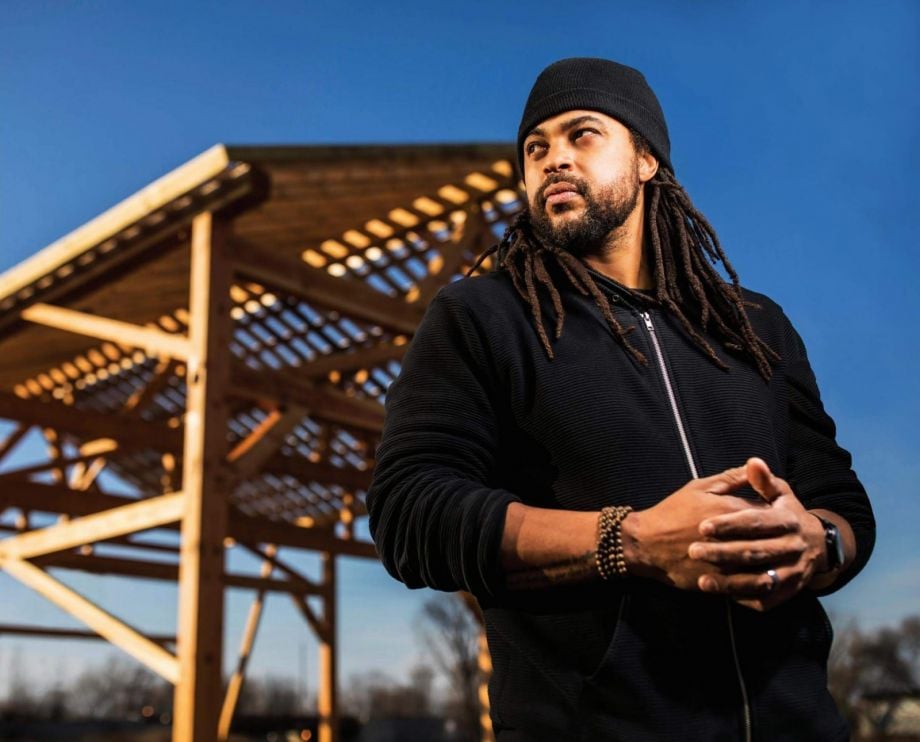
Sweet Water Co-Founder and Executive Director Emmanuel Pratt. (Photo courtesy Sweet Water Foundation)
Pratt stresses the fact that the commons were built not so much as a showpiece but as a catalyst to spark a variety of teaching and nurturing activities. The farm and gardens, by Sweet Water’s estimates, feed more than 200 residents weekly. The headcount of leaders and students fluctuates during the course of the year. A core team of 12 works year-round to coordinate — and balance — mentoring, planting, building, teaching and event-planning. From there, the organization can take in eight to 15 work-study students from Chicago-area colleges and high schools, along with a bumper crop of mentors and volunteers that show up in the summer. The organization also works with another 30 to 40 teens as part of a training program in conjunction with the Chicago Housing Authority.
Sweet Water is something of an anomaly in the world of creative placemaking, where art is the catalyst that drives community development. Practitioners typically use murals, spoken-word performances, music, dance and other art forms to draw people together, articulate issues, rally support and ultimately give neighborhoods and communities both the agency and capacity to change. Target issues range from housing to health, economics, education and more. The work makes a statement both within the community and to the world beyond the confines of that community.
Such programs frequently spark a jolt of life that, over time, makes previously downtrodden neighborhoods alluring to outsiders. It may begin as a boon — an economic upswing for existing restaurants, shops and other businesses. But ultimately, the groundswell attracts outsiders who can move in, bid up real estate and price longtime residents and businesses out.
The question of just how to execute creative placemaking without inviting gentrification sits at the forefront of creative placemaking circles. Jamie Hand, a researcher for ArtPlace America, says the friction between placemaking’s benefits and the onrush of gentrifying forces has happened frequently enough to spark vigorous discussion and dialogue on the efforts to walk a tightrope between uplift and displacement of the community.
One camp argues that for creative placemaking to be successful, efforts must generate an economic benefit for participating artists. “Linking arts to employment is at the leading edge of creative placemaking,” says Patrick Horvath of the Denver Foundation, a funding organization. “What we see is the potential for art in the community to act as an economic anchor. When we work to redevelop places, we invest in design to enhance the experience, but it can also create jobs for people in the neighborhood.”
Ultimately, placemaking must begin and be sustained with grassroots involvement. As Juliet Kahne, director of events and education for the Project for Public Spaces, writes in her essay Does Placemaking Cause Gentrification? It’s Complicated:
“Placemaking is a tool that connects community members to physical changes within their neighborhood, as well as to each other; it can help tackle the divisive, top-down, neighborhood change that is often associated with gentrification. It’s the importance of creating places that benefit everyone — places that connect existing residents, instead of dividing, alienating, or displacing them, and places that enhance the existing character of a neighborhood, instead of erasing it. Rather than watching passively as non-local or private developers consume neighborhood public spaces, we can use placemaking to enable citizens to create their own public spaces, to highlight the unique strengths of their neighborhoods, and to address its specific challenges. While gentrification can divide communities and build upon exclusivity, Placemaking is about inclusion and shared community ownership.”
In the case of Sweet Water, the key lies in reconnecting neighborhood residents to the land, and in building relationships that extend within Washington Park and outward to the world. In this feature, Next City digs into how Sweet Water has activated and engaged the surrounding community. And how other groups, in suburban Boston and Denver, leverage entrepreneurship and education as the means to strengthen target groups in the face of change.
Sweet Water has launched an extensive effort to teach the fundamentals behind a wide variety of its projects, including sustainable science, agriculture, design and carpentry. Besides the farm, garden, barn and meeting center, Sweet Water has built a customized greenhouse that serves as a carpentry workshop and makerspace. There’s also a pod made out of what was previously a shipping container for concentrated grape juice that has been repurposed as a grow-space classroom.
In many ways, Sweet Water started down a path that roughly parallels Pratt’s career in architecture, design and agriculture. Pratt, who has a bachelor’s in architecture from Cornell and a graduate degree in urban design from Columbia, has already led Sweet Water through a period of organic growth into several quite different, but interrelated projects. The organization launched about the same time Pratt created and ran an aquaponics department for Chicago State University. He secured funding to install demos of small sustainable aquaponics environments at schools in Chicago and in Milwaukee — connected installations that displayed the balance of fish and plant life and their ability to cycle the necessities of life (carbon dioxide, oxygen, water and nutrients). The U.S. Department of Agriculture took interest in the aquaponics project as well as urban farming prompted Pratt to think both within and beyond the classroom at the same time. He approached the city of Chicago about starting a farm and in time, those talks opened the way to Perry Avenue, an abandoned house and the four plots of land that Sweet Water took over.
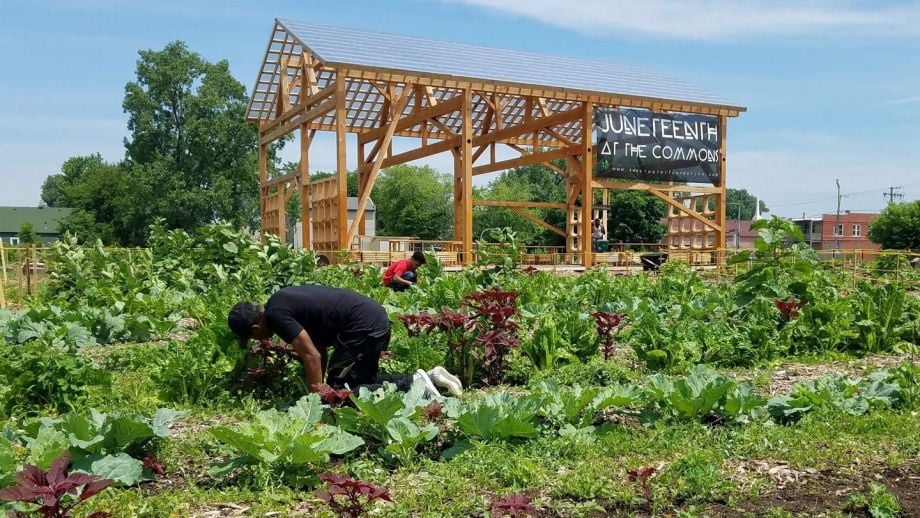
At the Perry Avenue Commons, volunteers pick leafy greens, with Sweet Water's barn in the background. (Photo courtesy Sweet Water Foundation)
While the group’s bedrock is a two-acre farm, under Pratt’s direction, Sweet Water took a turn from its education and farming roots into art and design installations as a way to better publicize the broad range of its work and vision. The carpentry and design enterprise manufactures furniture out of discarded wood pallets and glass that local contracting firms or the Chicago Transit Authority would normally pay to be sent to landfill. Sweet Water donates the tables, chairs and benches to open spaces in the area, and includes their creations in museum installations to promote the group’s work. They even build made-to-order pieces on commission.
In 2017, Pratt unveiled an exhibit at Chicago’s Smart Museum entitled “Radical [Reconstructions],” made up of several pieces. One was the representation of a house made of salvaged wood, which apprentices at Sweet Water charred using a traditional Japanese technique. An exhibit of Sweet Water furniture designs also appeared at the same time in the museum’s sculpture garden. Sweet Water has also installed its designs at Columbia College and the School of the Art Institute of Chicago. Pratt, meanwhile, has served as a visiting professor at the University of Michigan’s architecture school.
Sweet Water still has a hand in education, both in training young people in basic agriculture to work on the farm and in woodworking. “We started things out with our community garden, and then realized that we needed to build more infrastructure,” Pratt recalls.
Even as Sweet Water makes inroads in the Washington Park and Englewood neighborhoods that constitute its home base, Pratt senses the threat of gentrification. While not immediate, it remains a distinct possibility, and one that’s likely to arrive sooner rather than later given what has occurred on Chicago’s South Side over time. The area abounds with anchor institutions that, while a bit beyond walking distance from Perry Avenue, could still spark a land rush. Less than 15 minutes away by car are The University of Chicago and its medical center, as well as the Obama Presidential Center, slated to open in 2020. And Pratt’s Perry Avenue farm is less than five blocks from the Dan Ryan Expressway, making it essentially a 15-minute commute to the Loop.
The mortgage crisis of a decade ago was particularly hard on South Side neighborhoods, driving home prices down and African-Americans out. The city’s black population dropped more than 20 percent, from nearly 1.1 million in 2000 to 840,000 in 2016. And Sweet Water’s immediate neighborhood is mired in a struggle that is decades in the making. A 2010 University of Illinois at Chicago study summarizes what Washington Park still faces, compared to more affluent Hyde Park, the neighborhood surrounding the University of Chicago. Washington Park’s population has steadily shrunk over the past half-century, from 46,024 in 1970 to less than 12,000 in 2016. Neighborhood residents are 94 percent African American. The yearly median income for families is below $25,000 a year, compared to $51,430 in Hyde Park. In Washington Park, 43.5 percent of families live below the poverty line, compared with 11.4 percent of families in Hyde Park. Under 20 percent of adults in Washington Park have a college education.
Pratt characterizes his work as an effort to recreate the immediate community’s many interwoven relationships and sufficiences from the grassroots. He characterizes the connections forged from Sweet Water’s disparate projects — the farm, the apprenticeships, the installations and even big celebrations the organization holds such as its day-long Juneteenth festival — as mycelia, the almost invisible filaments that join together forest fungi and mushrooms into extensive colonies that represent the world’s largest organisms. Here, the vast unseen network is comprised of relationships. Pratt posits the example of a high schooler who signs on as an apprentice, someone whose world experience before Sweet Water probably extends no further than a 10-block radius around home. By working with mentors, conducting tours and presentations, leading workshops, coming in contact with graduate students from Harvard, or leaders from the Urban Farming Institute, the same South Side teen now easily gains direct contact and relationships with more than 1,000 people.
Just outside Boston in Somerville, Massachusetts, the local arts council has landed on a crafty way to hitch creative placemaking to the ever-expanding foodie boom. In this venture, immigrant chefs gain a stake in the game.
The program, called Nibble, grew out of walking tours of Union Square, a downtown area where 10 or so international markets had sprung up selling food from India, Brazil, Central America and other points around the globe. Nibble Program Director Rachel Strutt says the culinary walking tours seemed like a natural outgrowth of gallery walks or other ways to generate interest in local arts, while bringing together groups in greater Boston to commingle over a universal interest: good food.
Strutt says the walking tours were so popular that the arts council brainstormed additional ways to capitalize on the momentum. Nibble started with a blog to chronicle the stories of chefs, share recipes and spread the word about the ways local markets connected with groups around the world. It culled favorite recipes of local international chefs in a 130-page book that’s filled with stories, art and interviews about global cuisine and culture. Nibble also organized cooking classes marketed to yuppies and hipsters; at between $35 and $50 a ticket, it was a bargain compared to nearby adult-learning locations.
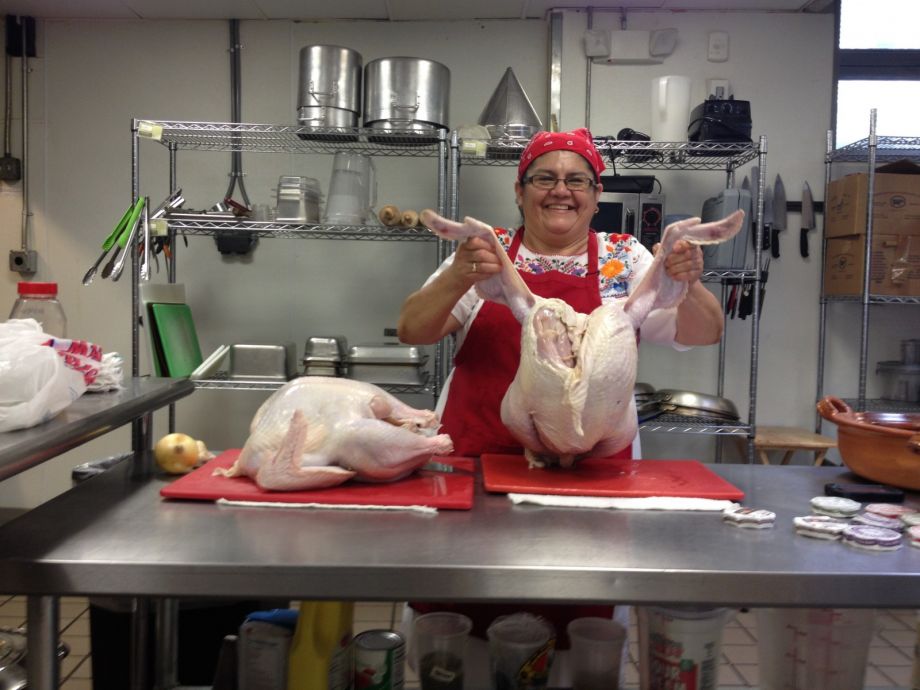
Nibble Culinary Entrepreneur Estela Calzada cooks Mexican and pre-Hispanic dishes for the organization’s festivals and pop-up events, and teaches cooking classes. Her specialty is mole. (Photo by Rachel Strutt)
As these promotions stirred up interest, Strutt says several cooking instructors asked about establishing more permanent culinary careers and even opening restaurants. It was clear, she says, that entrepreneur workshops were a natural next step. “We had all these great cuisines and chefs who had something to share, so it made sense,” she says. The curriculum focuses on the facets of starting and running a successful restaurant. One session covers promotion and marketing, while others focus on pricing and developing the type of replicable yet delicious recipes that are a cornerstone of a busy establishment.
“This type of workforce development aims to reduce the barriers that exist in taking a food business from dream to reality,” says Strutt. “Our program is a hybrid that marries workforce and entrepreneurial development with cultural programs. Our graduates are doing things like catering, teaching cooking classes or even helping us set up festivals.”
Nibble has an even bigger project on deck: A 420-square-foot kitchen vending space under construction in downtown Somerville. Nibble Kitchen will feature seven graduates of the program’s entrepreneur classes, each scheduled to run the restaurant in one-day shifts during the week. Strutt envisions a menu that will change cuisines daily, from Ethiopian to Mexican to Indian to Venezuelan fare, and beyond.
ArtPlace finds that culinary projects tap into a number of cultural trends. Food, after all, is a storehouse of memories, events and lore, a glue that binds people together. The foodie craze has swept into the American landscape with farmers markets, local production, agricultural tourism, community gardens and food festivals across the states. Food trucks are parked from coast to coast, and millennials regularly flood Instagram with snapshots of their meals. A Kresge Foundation announcement for Fresh, Local and Equitable funding generated a rousing 500 applications from across the U.S.
Nibble fits quite well within Somerville. Just northwest of Boston proper, the city is a community of just over 81,000 people and home to Tufts University. It is densely populated — 32,000 households packed into 4.2 square miles. Somerville has long welcomed immigrants. Starting around 2000 new waves of immigrants from Haiti, Brazil and Nepal arrived, and the city is now home to thriving Caribbean and Latinx communities. Presently, almost 25 percent of the city’s population was born outside the U.S. As an active sanctuary city, Somerville has established an office of immigration affairs and started a legal defense fund with neighboring Cambridge earlier this year to help with immigration, DACA and even deportation issues.
Somerville takes pride in its civic gourmandise and its culinary lore. The city is home to Fluff, the sticky marshmallow confection still stocked on grocery store shelves from coast to coast, and the focal point of the “What the Fluff?” food festival each September, which takes place in Union Square not far from Nibble’s future restaurant. Residents celebrate that and any number of other delicacies in as many as five outdoor food festivals during warm-weather months, including the Ignite Global Street Food and Fire Festival and YUM: A Taste of Immigrant City, a food festival that marked its 10th anniversary in April of this year.
Perhaps Nibble’s biggest contribution is to help immigrant chefs put down economically viable roots in a city that’s rapidly changing. Somerville’s location just outside Boston and next to bustling Cambridge has made it an attractive bedroom community. The city is in the midst of a housing squeeze that has caused average rents to surpass $2,300 a month as of 2015.
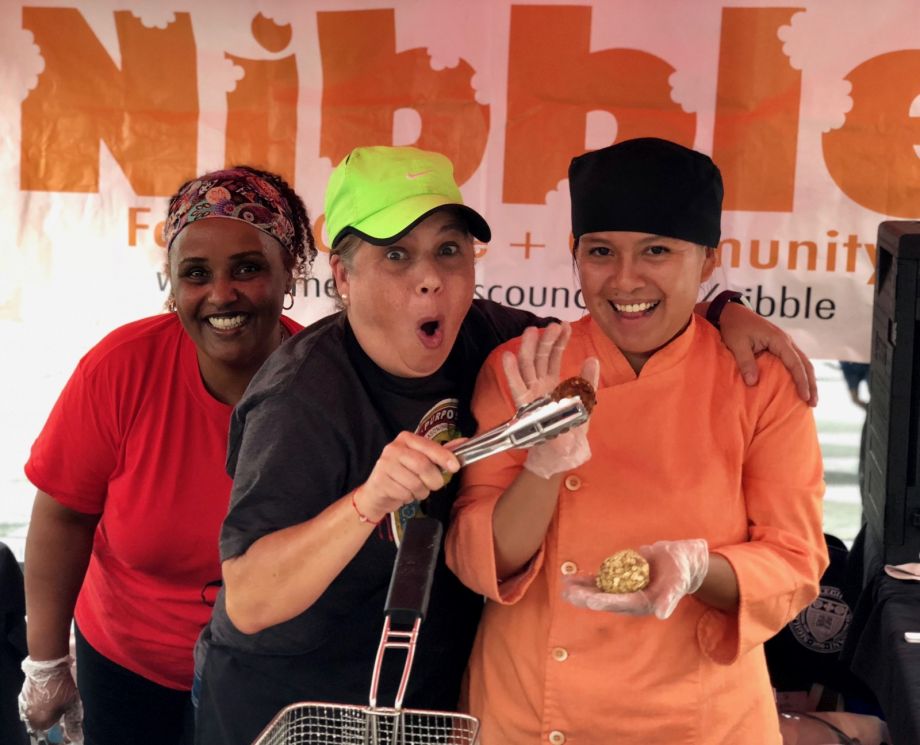
Nibble food entrepreneurs from left to right: Meqdes Mesfin, Carolina Garcia and Sandra Suarez. (Photo by Judy Yao)
Carolina Garcia wasn’t in the food industry before coming to Boston in 2015 from Caracas, Venezuela. She previously ran an engraving company, but through Nibble hit upon the idea of selling arepas, a cornmeal pancake wrapped around pulled pork, black beans or plantain, a handheld favorite back home thicker than but not unlike a tortilla. While other Venezuelans modify arepa dough with cheese or milk, she always favored a simple version using cornmeal, water and salt — a recipe that turned out to be a hit at fundraisers for her son’s school.
In the summer of 2016, she teamed up to run a Somerville food festival booth with longtime friend Carolina Salinas, who had moved to Boston a few years earlier. The two Carolinas found their cuisine was a hit with American palettes as well; they sold more than 200 arepas that day. “When we saw the lines, we wanted to cry for joy, but couldn’t stop because the two of us had to work fast to keep up,” Garcia says.
Together, the duo enrolled in Nibble’s entrepreneur’s program, and after that in the “Food Biz 101” program, run by Boston’s Commonwealth Kitchen. They won second place in a pitch contest held at the end of the course, and as their prize received pro bono consultations on licensing and business structure. Eleven months ago, Las Carolinas, as they call their venture, secured a license and since then have been negotiating with a local craft brewer to set up operations in the pub’s kitchen. In the meantime, Las Carolinas will vend arepas a few days a week in the Nibble Kitchen, once it opens.
Another program centered on helping artists establish paying careers is Denver’s Youth on Record (YOR), a nonprofit that offers free music and studio production courses to high school students as an incentive to finish school and get a diploma. The program was started just over 10 years ago by members of a local hip-hop group, The Flobots, which gained brief national success with the release of a hit song “Handlebars” in 2008. The organization focused its efforts on how to address a staggering 38 percent drop-out rate at Denver’s public high schools — a crisis that disproportionately affected the city’s Latino and African-American teens. Youth on Record garnered support from state and local agencies, including the Colorado Department of Education, A+ Colorado and Chalk Beat.
“An important part of truly creative placemaking is figuring how to keep artists in place, which in turn keeps vital cultures alive. We think we’ve found a balanced structure which allows artists to give back, and which keeps them [in the community].”
(Above: 4th Annual Youth on Record Block Party, performance by Rhyme Sight (left) and former YOR students Sly Guevara (center) and Levi Vigil (right); photo by Stephanie Mathena Photography.)
Youth on Record’s backdrop is a Denver that grapples with the companion ills of gentrification and a crisis of affordable housing, both of which have unfolded in several parts of the city over the last few decades. The Denver Foundation’s Horvath calls out one example in the Santa Fe district, formerly the center of the city’s Chicano community. Fifty years ago the city launched an urban renewal project which pushed out original residents to break ground on a community college campus. The gentrification of the area started picking up momentum nearly 20 years ago, when a district of art galleries publicized art walks on Fridays. And in Denver’s Five Points, long a majority African-American neighborhood, the recently dubbed RiNo, or River North Art District, has seen a more recent transformation as upscale restaurants, high-end housing and craft breweries have pushed rents and real estate prices skyward.
The underlying idea behind YOR is to offer classes in music production, performance, basic musicianship, piano and guitar as a means to lure back into classrooms students who had left high school or who were leaning toward quitting. Once enrolled, they could work toward earning diplomas or GEDs. The program not only teaches professional-level skills, but gives students access to a $2.2-million state-of-the-art media studio, which stays open six days a week.
Executive Director Jami Duffy estimates that 10,000 students have come through Youth on Record since its launch. The program is linked to nine schools in Denver and offers a series of programs at local public libraries as well. “We’re a social justice organization that seeks to inspire young people to organize in their home communities and take on civic engagement issues ranging from voting and planting gardens to healthcare,” says Duffy. “We’re about so much more than building music — I’d say our success rests on several pillars such as academics, mentorship and community activation.”
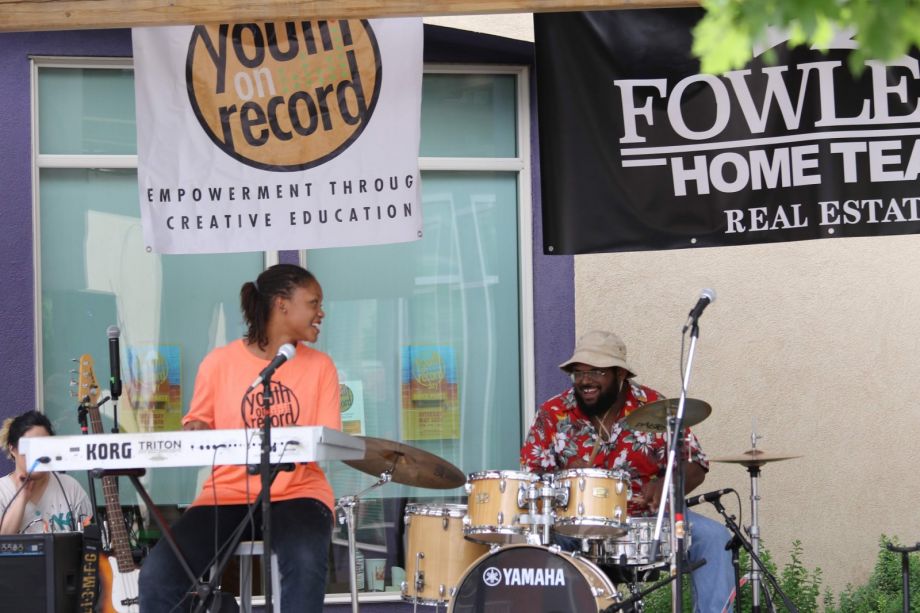
At the fourth annual Youth on Record block party, in 2018, Program Coordinator and Teaching Artist Devin Urioste plays drums, while YOR student Esperonza P. plays keyboards. (Photo by Stephanie Mathena Photography)
The Youth on Record curriculum is divided into two parts. Half of the classes are held in nine public schools and treatment centers, which reach about 1,000 students annually, Duffy estimates. Youth on Record instructors work with students from 14 to 21 years of age and enrollees are typically students who are struggling to complete the necessary credits to graduate from high school. The course offerings are as varied as audio production, how to produce backing tracks or beats or basic music engineering skills, all of which go toward satisfying mandatory elective credits.
There are a fair number of classes that help students charge their creative muses as well including music fundamentals. Offerings such as creative writing for the composition of lyrics, storytelling through music and slam poetry help fulfill English electives. Students find the classes not only beguiling but cathartic as well. “Allowing a young person to share their viewpoints is a creative outlet the students [we reach] look forward to every day,” Duffy explains. “Allowing a young person to tell their own story gives them a sense of agency in both their own lives and in their community.”
A second curriculum of classes takes place after school at the world-class 5,000 square-foot recording studio Youth on Record has set up in the Denver Housing Authority’s recently opened Mariposa housing development. Duffy describes those as smaller workshops that accommodate maybe 10 students at a time. Classes concentrate on honing skills both in the studio and on an outdoor performing stage in the development.
Youth on Record has also opened special classes. The Deep Dive program is a nine-month fellowship awarded to 14 handpicked students who have graduated high school or completed a GED. Those students receive a stipend and work toward a capstone recording or performance project while taking classes that cover the business of music, artistic principles and even personal wellness.
Early on, Youth on Record’s faculty noticed that young women in the program felt intimidated by the boys’-club atmosphere that pervaded this program’s classes as well as the music industry at large. In response, directors devised a special track of courses open to female students, called Fempowered.
Duffy ties Youth on Record’s success to the program’s ability to help students realize their dreams to become artists, even as they witness firsthand how artists work and pay their bills. “One thing I think sets us apart is that we’re employing professional artists and musicians,” she says. “One hundred percent of our staff are local musicians, grant writers, operations managers and teachers who live in the community.”
A number of other Youth on Record faculty, in fact, came up through the program itself. Jesus Rodriguez, the organization’s program coordinator and an accomplished recording engineer, interned with YOR before coming on as full-time staff in 2016. Fempowered’s lead teacher, Mona Magno, who also goes by the stage name Monalicious, is an alumnus who also runs a local organization called FreeMusicForFreePeople (FM4FP), which hosts showcases and fundraisers. “I’ve been performing since I was 13, and Youth on Record helped me establish my professional presence even more,” she recalls. “I released an album with one-on-one support from Molina Speaks, who helped me put together my vision and approach.”
It was a watershed moment, says Magno. “My work here provides a full-time salary, and I feel devoted to my work,” she adds. “I’ve become more aware of social justice issues and I am bringing more of that type of content to the classroom. Magno says the faculty hold readings as part of professional development efforts that have featured the likes of “Pedagogy of the Oppressed,” “Borderlands” and “A People’s History of the United States.” For Magno, “It’s opened my lens to my and my students’ realities. It helps me serve them more, and offer more resources relevant to their experience.”
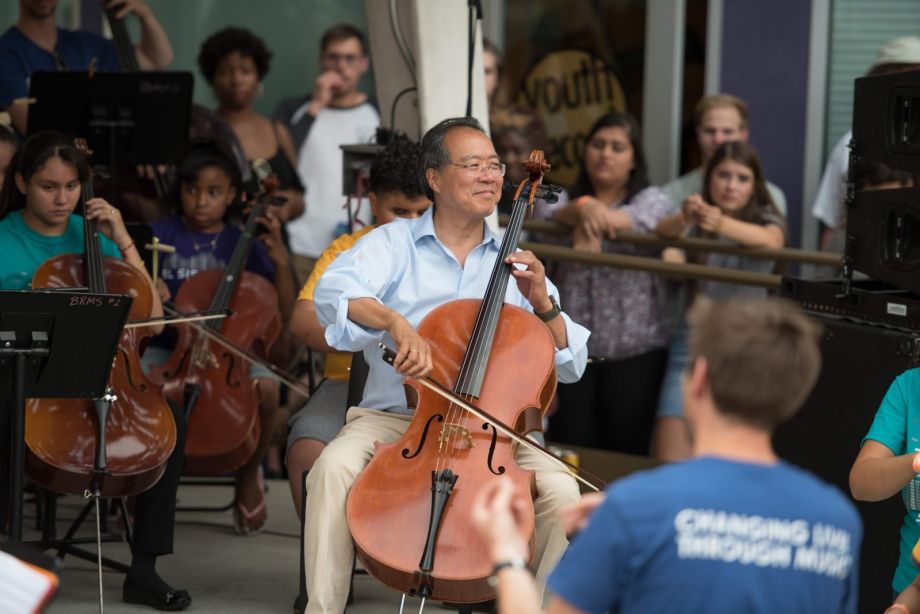
At an August 2018 event, reknowned cellist Yo-Yo Ma plays with members of the local El Sistema Colorado orchestra. (Photo by Ellen Jaskot)
Another instructor, Devin Urioste, is an artist who goes by the handle “Mace.” He began taking classes at Youth on Record in 2012, all while he was developing a personal visual-arts style inspired by the skateboarding circles he was frequenting. Youth on Record helped him finish high school. After graduation, he signed on as an intern to help run open labs and work as a co-teacher. He’s now working full-time, even while composing commissioned murals and preparing acrylic and collage works in mixed media for an exhibition at Rochelle Johnson Studio on July 6.
Duffy sees leveraging that lived experience as a critical aspect of YOR’s work, given how rapidly the cost of living in Denver proper has jumped as a result of development and climbing real estate prices. “An important part of truly creative placemaking is figuring how to keep artists in place, which in turn keeps vital cultures alive,” she says, adding, “We think we’ve found a balanced structure which allows artists to give back, and which keeps them [in the community].”
Questions about gentrification in many ways set some of the challenges urban creative placemaking faces in stark relief. Advocates debate how much utility or economic outcomes should serve as a yardstick of placemaking success, and mull over what lessons from a specific program can be applied in other communities. “We’ve known that the arts have a role and we have spent time helping policymakers grasp their significance in community development,” says Jamie Hand. “In the last 10 years, we’ve begun to get feedback from people on the front lines about what we need to address, particularly in relation to complex issues of race and equity.”
But Hand cautions that there may not be one quick fix. “How we think about replicability in this line of work — especially when it is so place-based and contextual — makes it risky to copy-and-paste a certain kind of project,” she notes. “It will take many more years to evolve the field in how to scale or replicate.”
EDITOR’S NOTE: This story has been updated to reflect corrected figures for the number of students that participate in Youth on Record each year, and the number who have participated since the program’s launch.
This article is part of “For Whom, By Whom,” a series of articles about how creative placemaking can expand opportunities for low-income people living in disinvested communities. This series is generously underwritten by the Kresge Foundation.

James A. Anderson is an English professor at the Lehman College (Bronx) campus of the City University of New York.

20th Anniversary Solutions of the Year magazine